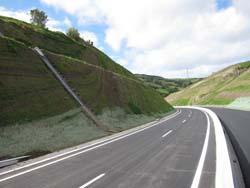Roadway Revegetation (Storm Water Solutions: March/April 2012)
March/April 2012
By Walter “Wally” Butman
Situated 930 miles west of Lisbon, Portugal, is a group of volcanic islands known as the Azores. This majestic archipelago, extending more than 370 miles, was created by prehistoric volcanic activity. Sao Miguel is the largest of the islands (293 sq miles) and was first settled in 1444. It became a Portuguese territory after the Portuguese Civil War in 1834.
The Azores provide a tranquil setting for local inhabitants as well as visitors hoping to enjoy the vast array of plant and animal life and the oceanfront scenery. San Miguel is nicknamed “The Green Island” for its tremendous variety of plant species. Ponta Delgada is the main port and tourist attraction at the southeast corner of Sao Miguel.

As population and local transportation needs have increased, the original roads in Sao Miguel have proven to be too narrow; they also curve relentlessly through difficult terrain, requiring extended travel times over even the shortest distances. Two new major roadway projects recently were developed to improve local transportation in both the northern and southern sectors of the island.
Project Plans
Ferrovial, one of the largest construction companies in Spain, took on the challenge of developing the major construction plan in early 2010. Ferrovial turned to Spanish seed, fertilizer and erosion control materials supplier Commercial Projar for the revegetation work. Projar’s contracting division had a small window of opportunity to complete highly sensitive sections of the project before bad weather set in.
“The revegetation on this project was no small task given the difficult terrain and various seasonal weather conditions,” said Projar Technical Manager Pablo Navarro.
The north and south roadway projects were separated by just five miles, but the difference between them was incredible. Variations in soil types and rainfall quantities were dramatic.
The soil in the south is composed mostly of pumice stone, and is extremely coarse in texture, highly erodible and low in organic content. The southern climate is much warmer and drier, providing significant challenges to vegetation establishment.
The northern sector of the project included higher organic content in the soil and a variety of granulations, with consistent rainfall and milder temperatures during the spring and summer months.
These extreme variances required a wide variety of applications and materials to get the job done. Projar Field Manager Jorge Forte recommended six different hydraulic erosion control product applications (HECPs) depending mostly on soil types, slope degree (many 1 to 1) and climatic conditions. The initial contract was finalized in October 2010 for Projar’s erosion control division to take on both the north and south projects.
Erosion Control Answers
Two hydroseeders with 800- and 1,500-gal capacities were mobilized to the Azores, along with five workers, one project coordinator and two water trucks to supply the hydroseeders. The hydroseeders were equipped with aggressive mechanical agitation, allowing for quick and efficient mixing and discharge of the thick hydraulic slurry materials. Given the steep slopes created by Ferrovial in an effort to reduce the land take, sometimes the top of the tiered slopes reached well over 60 meters. The 800-gal hydroseeder proved to be very nimble around the tight-access portions of the project site.
Eco-Flex Flexible Growth Medium (FGM) was specified on the most difficult slope conditions at a 4,000-lb-per-acre application rate. Eco-Aegis Bonded Fiber Matrix (BFM) was specified at 3,500 lb per acre where soil conditions were more desirable, but erosion remained a major concern.
The FGM material was composed of thermally refined wood fiber, special tacking chemistry and moisture absorption polymers that create an excellent erosion control medium while providing an ideal microenvironment for seed germination and establishment. Two of the most important features of the FGM material are that it requires no setup time after application in order to provide effective erosion control and that it is 100% biodegradable, which was important to the Azores project engineers.
On flat or mildly rolling terrain, Eco-Fiber wood fiber hydraulic mulch with tackifier was chosen. All critical exposed areas were covered by April 2011, at which time planting ceased until the dry, hot season passed and work could be completed in the fall.
Multisolution Success
Profile Products Vice President of International Business Development Tammy Harney suggested Projar utilize “prescriptive agronomic formulations,” choosing various hydraulic additives in order to enhance seed germination, establishment, root development and plant vitality. Given the site conditions, the combination of the various hydraulic erosion control products, site-specific seed selection and prescribed additives ensured vegetation and erosion control success. Nearly 100 acres were covered on the south roadway, and about 40 acres were covered in the north.
The Azores roadway project serves as an example of a general contractor, erosion control contractor and material supplier partnering to find a solution for a challenging environment. A project that seemed to pose insurmountable challenges ultimately proved to be a success for both Ferrovial and Projar, leading to additional related project work.
Today, Azores inhabitants and tourists enjoy picturesque views while traveling the new roadways around Sao Miguel.
Walter “Wally” Butman is vice president of distribution and international sales for Profile Products. Butman can be reached at wbutman@profileproducts.com or 847.215.3440.
As seen on estormwater.com for the original article visit here.

